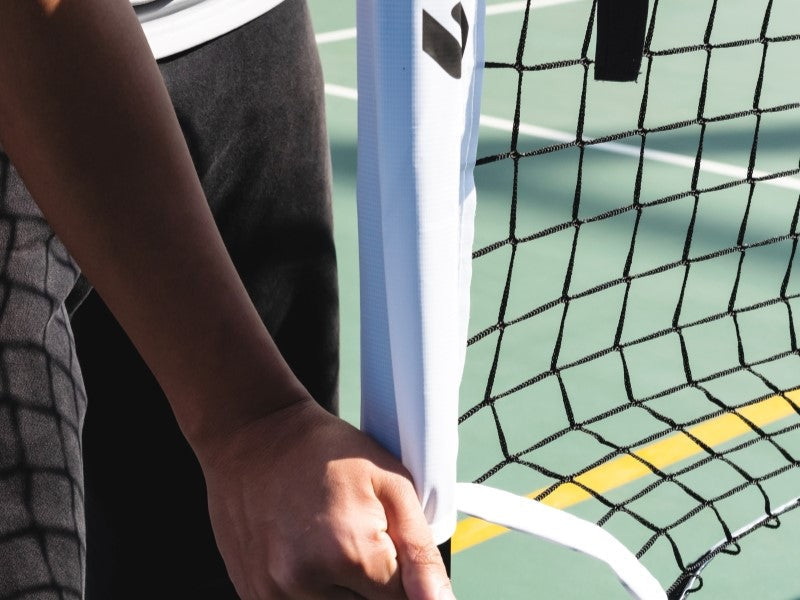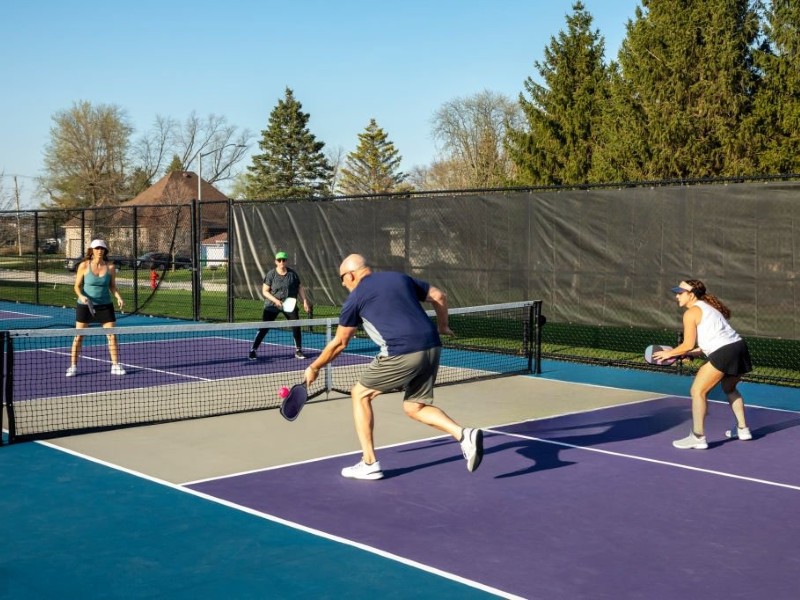As both pickleball and tennis grow in popularity across various age groups, more and more players are converting or sharing courts between the two sports. However, a common question arises when adapting or constructing a court: should you use a pickleball net or a tennis net? Although they may appear similar at a glance, the differences between a pickleball net and a tennis net are significant and can affect your gameplay, safety, and even regulatory compliance.
Similarities and Differences Between Pickleball Nets and Tennis Nets

While pickleball nets and tennis nets serve different sports, they share several structural similarities that can sometimes lead to confusion. However, a closer look reveals distinct differences in dimensions, design, and intended use that are critical for proper gameplay.
Similarities:
- Basic Structure Both nets consist of mesh netting suspended between two posts with a center strap or cord to maintain proper tension and height.
- Net Materials Most use durable nylon or polyethylene mesh and have vinyl or fabric headbands along the top to reduce wear.
- Setup Concept Whether permanent or portable, both nets are designed to create a clear division of the court and regulate shot trajectory.
Differences:
- Portability Pickleball nets are often lightweight and portable, ideal for temporary setups. Tennis nets are typically fixed and supported by heavy-duty posts and cable systems.
- Court Compatibility A tennis net is too wide and tall for standard pickleball courts, while a pickleball net is too short and narrow for tennis play.
The Dimensions and Height Differences
According to the official rules provided by USA Pickleball and the International Tennis Federation (ITF), these measurements are clearly defined.
A standard pickleball net is 22 feet wide and 36 inches high at the sidelines, dipping slightly to 34 inches at the center. This lower net height accommodates the unique paddle-and-ball dynamic of pickleball, allowing for a faster pace and greater shot control, especially near the non-volley zone, or kitchen.
In contrast, a tennis net measures 42 feet wide—suitable for the width of a doubles court—and stands 42 inches high at the posts and 36 inches high at the center. Because tennis involves more powerful, high-velocity shots with a larger racquet and ball, the higher net is necessary for proper play and safety.
Why Net Height Matters
At first glance, a difference of just a few inches may seem minor, but in practical gameplay, those inches greatly impact strategy and shot technique. For example, in pickleball, players frequently engage in “dinking,” or soft volleys just over the net within the non-volley zone. A lower net makes these plays easier to execute and defend.
If a tennis net is used for pickleball without any height adjustment, it can create a steeper angle for the ball, disrupt game balance, and put players at a disadvantage—especially those who rely on precise kitchen play.
On the other hand, using a pickleball net for tennis is not advisable at all. The shorter width and lower height do not meet the needs of a tennis game, potentially leading to poor gameplay and even injuries.
Construction and Material Considerations
Pickleball nets are typically lighter and more portable than tennis nets. Most are made with a powder-coated steel or aluminum frame, polyethylene netting, and are designed for easy setup and takedown. They’re ideal for temporary or multi-use courts, community centers, and gymnasiums where courts might serve multiple sports.
Tennis nets, meanwhile, are built for permanence and endurance. They often feature double mesh at the center, vinyl-coated headbands, and heavy-duty cable systems. They’re anchored to permanent net posts and require professional installation.
If your court is permanent and dedicated to one sport, then choosing the corresponding net type makes sense. But if your court needs to be flexible, a portable pickleball net system might be the better choice, especially if retrofitting a tennis court for multi-use.
Converting a Tennis Court for Pickleball Use

One of the most common questions facility managers and recreational players ask is: Can a tennis court be converted into a pickleball court? The answer is yes, and it’s being done more frequently across the U.S. due to the surge in pickleball popularity.
To convert a tennis court for pickleball, several changes must be made. Most importantly, you'll need to install temporary pickleball nets, as tennis nets are too wide and tall. Some portable pickleball net systems are designed to be quickly assembled and disassembled, making them ideal for shared spaces.
You can also mark temporary pickleball lines using tape or chalk, or install permanent pickleball lines in a different color. This lets you switch between tennis and pickleball play easily.
Another innovative solution involves lowering the tennis net at the center strap to the appropriate 34-inch height for pickleball and installing temporary side posts to narrow the width. While not a perfect substitute, this hybrid method allows casual pickleball games without major structural changes.
Pros and Cons of Using a Tennis Net for Pickleball
Pros:
- No additional equipment needed if you already have a tennis net
- Cost-effective for casual or occasional pickleball play
- Minimal court modification
Cons:
- Net height is too high in the center, altering game dynamics
- Net width is too long, causing awkward angles and spacing
- Not suitable for competitive or tournament-level pickleball
Pros and Cons of Installing a Pickleball Net
Pros:
- Optimized for correct gameplay dimensions and regulations
- Lightweight and easy to set up or store away
- Enhances player experience with proper bounce and angles
Cons:
- Requires purchase of new equipment
- May not be durable enough for long-term outdoor use
- Takes up space when not in use
Ideal Scenarios for Each Net Type
If you're unsure which net to choose, consider the following scenarios to guide your decision:
- Dedicated Pickleball Court: Choose a regulation pickleball net. It provides the best gameplay, meets official standards, and ensures consistent performance.
- Dedicated Tennis Court: Stick with a tennis net unless you're adding temporary pickleball play. Consider investing in a center strap adjustment or temporary posts for partial conversions.
- Shared or Multipurpose Court: Invest in a portable pickleball net system. It offers flexibility, easy setup, and doesn’t interfere with tennis matches when removed.
- Recreational Backyard Court: Either net can work depending on what you play more often. Combo nets or adjustable nets may be a good solution for families who enjoy both sports.
Safety Considerations
Incorrect net height or sagging nets can lead to tripping hazards or improper posture during gameplay. Always ensure that the net is properly tensioned and at regulation height before play begins. For shared courts, clearly mark playing areas and communicate the sport in play to prevent collisions or confusion.
Additionally, storing portable nets properly and checking for wear and tear can prevent accidents. Replace any damaged netting or parts immediately to maintain safety standards.
Budget and Investment
Pickleball nets are generally less expensive than tennis nets. A high-quality portable pickleball net system can range from $100 to $300, while a professional-grade tennis net with posts and installation might exceed $500. If you're on a budget or managing multiple courts, the cost savings of using dedicated pickleball nets or combo systems can be significant.
However, consider the long-term value. A net that suits your primary sport, improves player satisfaction, and requires minimal maintenance is often the smarter investment.
Choosing between a pickleball net and a tennis net ultimately comes down to how the court will be used. If pickleball is your main game, investing in a regulation net is essential for optimal play, accuracy, and enjoyment. If you’re maintaining a multi-use facility or playing casually, a portable or combo net may provide the flexibility and convenience you need.









Leave a comment
This site is protected by hCaptcha and the hCaptcha Privacy Policy and Terms of Service apply.